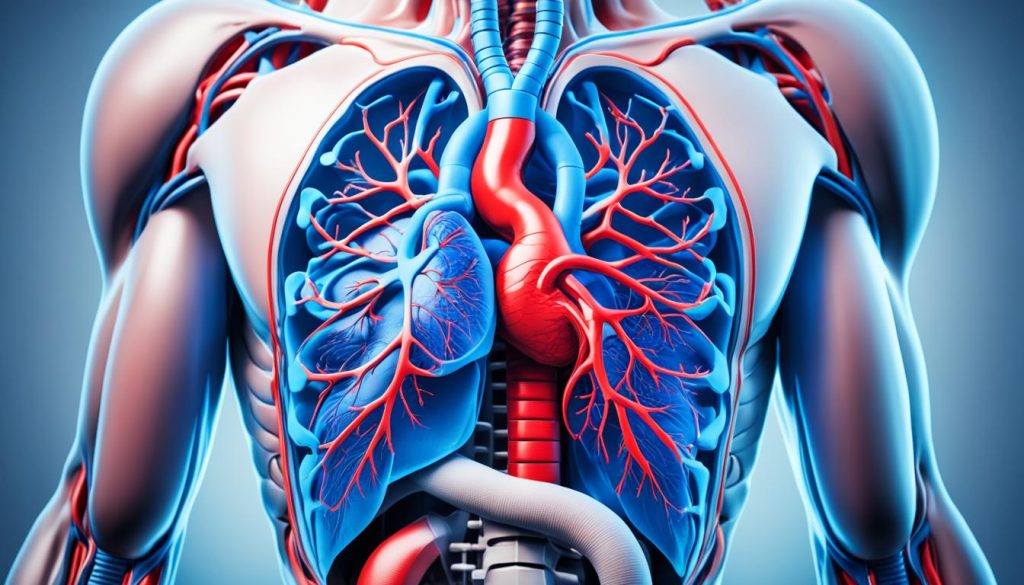Do you find yourself frequently taking deep breaths or experiencing shortness of breath? It can be a cause for concern and leave you wondering why you feel this way. In this article, we will explore the possible reasons behind this constant need to take deep breaths and the potential underlying causes.
Shortness of breath, also known as dyspnea, can be a symptom of various conditions, including asthma, COPD, pulmonary hypertension, respiratory tract infections, and heart conditions. It can manifest as difficulty catching your breath, feeling the need to breathe more quickly or deeply, or not being able to take a full, deep breath.
It is important to address these breathing difficulties and not dismiss them as mere inconvenience. Shortness of breath can also be a sign of a more serious underlying condition that requires medical attention. Ignoring the symptoms may delay diagnosis and treatment, potentially worsening the situation.
Stay tuned to uncover the causes of shortness of breath and gain a better understanding of when it might indicate a serious issue. By identifying the root cause, you can take appropriate steps to alleviate your symptoms and improve your overall well-being.
What Causes Shortness of Breath?
Shortness of breath, characterized by the persistent need to take deep breaths, can be caused by several factors. Identifying the underlying cause is crucial for appropriate treatment and relief from this sensation.
Asthma and COPD
Asthma and chronic obstructive pulmonary disease (COPD) are common respiratory conditions that can lead to shortness of breath. Asthma causes inflammation and narrowing of the airways, while COPD, including emphysema and chronic bronchitis, results in difficulty breathing due to damaged lung tissues. Both conditions can cause shallow breathing and a constant need to take deep breaths.
Pulmonary Hypertension and Fibrosis
Pulmonary hypertension, a condition in which the blood pressure in the lungs is elevated, can cause shortness of breath and a deep breathing sensation. Pulmonary fibrosis, characterized by the scarring of lung tissues, can also lead to breathing difficulties and a persistent need to breathe deeply.
Respiratory Tract Infections
Respiratory tract infections, such as pneumonia and bronchitis, can cause shortness of breath as the infection affects the lungs and airways. The body’s response to the infection can result in shallow breathing, frequent deep breaths, and a chronic urge to take deep breaths.
Heart Conditions
Heart conditions, including heart failure and coronary artery disease, can lead to shortness of breath. The heart’s inability to pump blood effectively can cause insufficient oxygen supply to the body, resulting in the constant need to breathe deeply.
Obesity and Lack of Exercise
Obesity and being out of shape can contribute to shortness of breath. Excess weight and lack of physical fitness put strain on the respiratory system, making it more difficult to breathe and leading to frequent deep breaths.
Anxiety and Panic Attacks
Anxiety and panic attacks can manifest as physical symptoms, including shortness of breath. The body’s response to stress and anxiety can result in shallow breathing and a feeling of not being able to take full, deep breaths. This can create a chronic urge to take deep breaths as a way to relieve anxiety.
Other Serious Conditions
Shortness of breath can also be a symptom of other serious conditions, such as pulmonary embolism (a blockage in the lung artery) or a heart attack. These conditions require immediate medical attention.
Identifying the underlying cause of shortness of breath is essential for appropriate diagnosis and treatment. By addressing the root cause, individuals can find relief from the constant need to take deep breaths and improve their overall respiratory health and well-being.
| Cause | Description |
|---|---|
| Asthma and COPD | Inflammation and narrowing of the airways, leading to difficulty breathing |
| Pulmonary Hypertension and Fibrosis | Elevated blood pressure in the lungs or scarring of lung tissues, affecting breathing |
| Respiratory Tract Infections | Infections in the lungs and airways, causing breathing difficulties |
| Heart Conditions | Cardiovascular issues resulting in insufficient oxygen supply to the body |
| Obesity and Lack of Exercise | Excess weight and poor physical fitness straining the respiratory system |
| Anxiety and Panic Attacks | Stress and anxiety leading to shallow breathing and a constant need to take deep breaths |
| Other Serious Conditions | Pulmonary embolism or heart attack, requiring immediate medical attention |
When Is Shortness of Breath Serious?
Shortness of breath should always be taken seriously, especially if it is moderate to severe and occurs suddenly, accompanied by chest pain, lightheadedness, or changes in skin color. These symptoms may indicate a heart attack or pulmonary embolism, which require immediate medical attention. Even if shortness of breath is milder and occurs only during physical activity, it should not be ignored as it can be a sign of a more serious condition.
In some cases, shortness of breath may be a result of less severe factors like being out of shape or anxiety. However, it is important to consider the duration, intensity, and accompanying symptoms to determine the seriousness of the situation. If shortness of breath persists or worsens, it is recommended to seek medical advice to rule out any underlying conditions.
To help you better understand when shortness of breath may be serious, refer to the table below:
| Symptoms | Potential Severity |
|---|---|
| Shortness of breath with sudden onset | High severity |
| Shortness of breath accompanied by chest pain or pressure | High severity |
| Shortness of breath with lightheadedness, dizziness, or confusion | High severity |
| Shortness of breath with bluish or pale skin | High severity |
| Mild shortness of breath during physical activity | Moderate severity |
| Shortness of breath that improves with rest | Lower severity |
| Shortness of breath accompanied by persistent cough | Varies depending on underlying cause |

Remember, it is always better to err on the side of caution when it comes to your health. If you experience any concerning symptoms or are unsure about the seriousness of your shortness of breath, consult a healthcare professional for a thorough evaluation and appropriate guidance.
Shortness of Breath Explained
Shortness of breath, also known as dyspnea, is a sensation of breathlessness or the feeling of not being able to get enough air into the lungs. It occurs when the body doesn’t receive enough oxygen, leading to a natural response to breathe harder or deeper in an attempt to compensate.
This condition can have serious consequences for overall health, both in the short and long term. Organs in the body require sufficient oxygen to function properly, and when there is a lack of oxygen, they may not perform optimally. The consequences of shortness of breath can range from mild discomfort to severe physical limitations, impacting daily activities and quality of life.
Shortness of breath can be caused by various conditions, including respiratory disorders such as asthma, chronic obstructive pulmonary disease (COPD), or pulmonary fibrosis. Heart conditions, such as heart failure or heart disease, can also contribute to the sensation of breathlessness. Additionally, other factors such as obesity, being out of shape, or anxiety and panic attacks can lead to this symptom.
To determine the underlying cause of shortness of breath, it is crucial to undergo tests and receive a proper diagnosis from a healthcare professional. Diagnostic tests may include lung function tests, blood tests, chest X-rays, or electrocardiograms. These tests help identify the specific condition or factors contributing to the shortness of breath.
Treatment for shortness of breath depends on the underlying cause. It may involve lifestyle changes, such as maintaining a healthy weight or quitting smoking. Medications, such as bronchodilators or anti-anxiety medications, may be prescribed to alleviate symptoms. In some cases, referral to specialists like pulmonologists or cardiologists may be necessary for further evaluation and management.
Overall, recognizing the significance of shortness of breath is essential in addressing this symptom effectively. Seeking medical attention, undergoing necessary tests, and following a comprehensive treatment plan can help improve lung function, alleviate discomfort, and promote overall well-being.
The Consequences of Shortness of Breath
The consequences of shortness of breath can vary depending on the severity and underlying cause of the condition. Here are some potential consequences:
- Reduced physical endurance and limitations in activities of daily living
- Decreased productivity and quality of life
- Increased risk of complications from underlying health conditions
- Greater dependence on healthcare services and medications
- Impaired sleep quality and disrupted sleep patterns
- Heightened anxiety and emotional distress
- Potential complications in performing certain occupations or hobbies
To prevent or manage these consequences, it is crucial to address shortness of breath promptly and receive appropriate treatment to mitigate its impact on overall well-being.
Example Table:
| Condition/cause | Main symptoms | Treatment options |
|---|---|---|
| Asthma | Wheezing, coughing, chest tightness | Inhaled bronchodilators, corticosteroids, avoiding triggers |
| Chronic obstructive pulmonary disease (COPD) | Chronic cough, excess mucus production, wheezing | Smoking cessation, bronchodilators, pulmonary rehabilitation |
| Pulmonary fibrosis | Progressive shortness of breath, dry cough | Oxygen therapy, pulmonary rehabilitation, lung transplant in severe cases |
| Heart failure | Fluid retention, fatigue, swollen ankles | Medications (diuretics, ACE inhibitors), lifestyle changes (diet, exercise) |

Sighing and Shortness of Breath
Sighing is a natural and instinctive behavior that involves taking a long, deep breath followed by a slow exhale. It is often associated with emotions such as relief, frustration, or sadness. Interestingly, sighing also serves a physiological purpose in maintaining lung function.
While sighing is considered normal and important for respiratory health, excessive sighing can be a sign of an underlying respiratory condition or uncontrolled anxiety or depression. When someone sighs a lot, it may indicate that their body is trying to compensate for a shortness of breath or an inability to fully expand the lungs.

Excessive sighing can also be a response to anxiety or depression. These emotional states can lead to rapid, shallow breathing or hyperventilation, making sighing more frequent. In some cases, sighing can provide a sense of relief and help reduce tension, especially in individuals with anxiety sensitivity.
Understanding the relationship between sighing and shortness of breath is crucial in identifying the underlying cause of excessive sighing. If someone is sighing a lot and experiencing persistent shortness of breath, it is important to consult a healthcare professional for a proper evaluation and diagnosis. They can help determine whether the excessive sighing is a symptom of a respiratory condition or related to anxiety or depression.
Potential Causes of Excessive Sighing
Excessive sighing is a phenomenon that can be caused by various factors, including stress, anxiety, depression, and respiratory conditions such as asthma and COPD.
Stress and anxiety can lead to quickened or rapid breathing, which often includes hyperventilation and increased sighing. The body’s stress response can trigger this respiratory pattern, causing individuals to take deep breaths, including sighs, as a way of coping with heightened emotions or tension.
Depression can also contribute to increased sighing. It is known that individuals with depression often have difficulty expressing their emotions verbally, leading to somatic complaints such as excessive sighing. Sighing may be a way to unconsciously release negative emotions or pent-up feelings.
Furthermore, respiratory conditions like asthma and COPD can cause increased sighing due to difficulty in breathing. These conditions can lead to a feeling of not getting enough air, which can result in sighing as a means of compensating for the perceived lack of oxygen or relief in the respiratory system.
If you find yourself sighing excessively or it becomes a concern, it is important to consult a healthcare professional. They can help determine the underlying cause and provide appropriate guidance or treatment to address the excessive sighing and any associated symptoms.

Possible Causes of Excessive Sighing:
- Stress
- Anxiety
- Depression
- Asthma
- Chronic Obstructive Pulmonary Disease (COPD)
Addressing Shortness of Breath
The treatment of shortness of breath depends on the underlying cause. It is important to consult with a healthcare professional for a proper diagnosis and treatment plan. Breathing and relaxation methods, such as deep breathing exercises and meditation, can provide temporary relief. Additionally, various tests may be conducted to determine the cause of the shortness of breath.
Lung Function Tests
Lung function tests are commonly used to assess the efficiency of the lungs and diagnose respiratory conditions. These tests measure lung capacity, airflow, and how well oxygen is transferred into the bloodstream. Common lung function tests include:
- Spirometry: Measures the amount of air you can breathe in and out, as well as how quickly you can exhale.
- Pulse oximetry: Measures the oxygen saturation levels in your blood.
Other Diagnostic Tests
In addition to lung function tests, a healthcare professional may order other diagnostic tests to identify the underlying cause of shortness of breath. These tests may include:
- Blood tests: Can help identify any infections, allergies, or other abnormalities.
- Chest X-rays or CT scans: Provide detailed images of the chest to detect any abnormalities in the lungs or surrounding structures.
- Electrocardiogram (ECG): Records the electrical activity of the heart to evaluate heart function.
Once a proper diagnosis is made, treatment options can be explored. Treatment may involve medications, lifestyle changes, and management of underlying conditions that contribute to shortness of breath. It is important to follow the guidance of healthcare professionals to effectively address and manage shortness of breath.
Conclusion
Shortness of breath can be a distressing symptom that should not be ignored. Whether it is caused by respiratory conditions, stress, anxiety, or depression, seeking medical attention is crucial to properly diagnose the underlying cause and receive appropriate treatment.
While breathing and relaxation methods can provide temporary relief, addressing the root cause of the shortness of breath is important for long-term management. With proper care and management, individuals can improve their lung function, reduce anxiety, and enhance their overall well-being.
Don’t let shortness of breath hold you back. Consult with a healthcare professional to determine the best course of action and regain control of your respiratory health.




